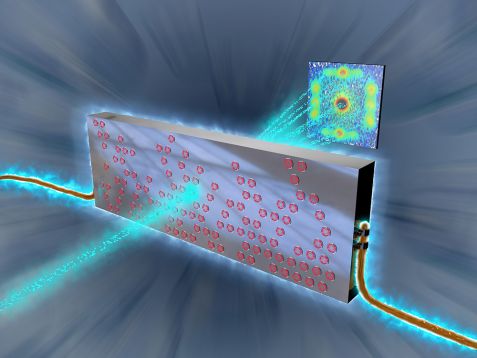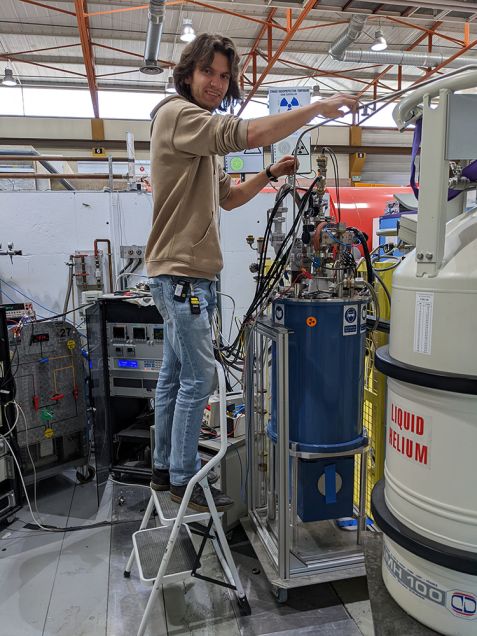MLZ is a cooperation between:
 > Technische Universität München
> Technische Universität München > Helmholtz-Zentrum Hereon
> Helmholtz-Zentrum Hereon
 > Forschungszentrum Jülich
> Forschungszentrum Jülich
MLZ is a member of:
 > LENS
> LENS > ERF-AISBL
> ERF-AISBL
MLZ on social media:

MLZ (eng)
Lichtenbergstr.1
85748 Garching
30.06.2022
Not just a phase…

Schematic layout of the experiment. The incoming neutrons scatter off the flux tubes and result in a scattering pattern from which Xaver Brems can deduce how the domains are arranged. The current is applied perpendicular to the flux tubes. © Reiner Müller / FRM II
Superconductors can not only conduct electricity without resistance and are in demand for high magnetic fields. They are also an ideal playground for fundamental research, where physicists test theories for general physical phenomena. In a collaboration between the MLZ and the Institut Laue-Langevin (ILL) in Grenoble, PhD student Xaver Brems used superconductors to investigate how different phases in a solid are interconnected.
In physics, phase refers to the different states in which matter can be found. Water, for example, can be in the liquid, gaseous or solid phase, depending on pressure and temperature. All three phases can coexist, given the right conditions.
… but rather two in coexistence
Certain superconductors, so-called Type II superconductors, can be in two phases that can coexist as well under suitable conditions. Unlike water, these do not differ in their state of matter, but in the way they react to external magnetic fields. In addition to their ability to conduct electric current without loss, superconductors are characterized by the way in which they shield external magnetic fields.
Depending on the phase, they do this in two different ways. Below a certain magnetic field strength, a Type II superconductor is in the Meissner phase and completely shields the external magnetic field. This is also referred to as a perfect diamagnet. At stronger field strengths, it changes to the so-called mixed phase and the magnetic field can penetrate the superconductor but is confined to regularly arranged tube-like structures. These flux tubes conduct electricity and the magnetic field can only assume discrete values, meaning it is quantized. In certain materials, such as niobium, and at the right temperatures and magnetic field strength, both phases coexist in the superconductor. This is known as the intermediate mixed state and it results in the formation of several self-contained regions, so-called domains, in which only one of the two phases is present.
Superconductors as an ideal laboratory for domain physics

Xaver Brems inserts his probe into the cryostat, to reach the superconducting phase. The technical challenge was to maintain stable temperatures despite the large current that he had to apply. © FRM II / TUM
In his publication, Xaver Brems, together with physicists from the Technical University of Munich (TUM) and the ILL, investigated how these domains organize themselves when current flows. They received academic and theoretical support by an international team from Germany, Russia and Brazil. For their investigation they exploited the Lorentz force that acts on charged particles when they move in a magnetic field. In a superconductor, current (i.e. moving charges) can only flow within the mixed phase and at the surface of the sample, and thus only flux tubes and the domains in the mixed phase are affected by the Lorentz force. However, the fact that the Lorentz force acts perpendicular to the current and magnetic field on the flux tubes results in an interesting scenario where a force perpendicular to the current acts on one of the two domains in an inhomogeneous two-phase system.
“With this work, we wanted to test whether we could use an intermediate mixed-state superconductor as a laboratory for general studies in domain physics,” explains Xaver Brems. “The biggest technical obstacle was to keep the millimeter thin strip-shaped niobium sample at a constant temperature of 4 degrees above absolute zero while simultaneously applying a current about five times larger that household sockets are designed for. At the same time, the measurement setup had to allow us to perform small-angle neutron scattering experiments,” he continues.
Shared PhD position at MLZ and ILL
The experiment was a great success and the results give Xaver Brems and his supervisors Dr. Sebastian Mühlbauer (MLZ) and Dr. Robert Cubitt (ILL) confidence. “Using small-angle neutron scattering at ILL, we have seen that the previously disordered domains in the mixed phase arrange themselves perpendicular to the current flow when applying the current, and that a kind of stripe pattern forms in the process,” Sebastian Mühlbauer announces with satisfaction.
The project was a success from a cooperation point of view as well. Xaver Brems is continuing his research together with Sebastian Mühlbauer and Robert Cubitt in a PhD position shared by both institutes. And there is still a lot to do: “Next, we want to investigate in greater detail the influence of different magnetic field strengths and better understand how the current is transported between the individual domains of the mixed phase depending on the area ratios of the domains,” Xaver Brems describes his plans for the next steps.
Original publication:
Current-induced self-organization of mixed superconducting states. Xaver S Brems, Sebastian Mühlbauer, Wilmer Y Córdoba-Camacho, Arkady A Shanenko, Alexei Vagov, José Albino Aguiar and Robert Cubitt. Superconductor Science and Technology, Volume 35, Number 3 (2022) IOP Publishing Ltd. DOI: 10.1088/1361-6668/ac455e
More information:
The measurements were performed at the small angle scattering facility D33 at ILL in Grenoble. On the theoretical side, the physics departments of the Federal University of Pernambuco in Brazil, the HSE University in Moscow and the Institute for Theoretical Physics III of the University in Bayreuth were involved.
MLZ is a cooperation between:
 > Technische Universität München
> Technische Universität München > Helmholtz-Zentrum Hereon
> Helmholtz-Zentrum Hereon
 > Forschungszentrum Jülich
> Forschungszentrum Jülich
MLZ is a member of:
 > LENS
> LENS > ERF-AISBL
> ERF-AISBL
MLZ on social media:


